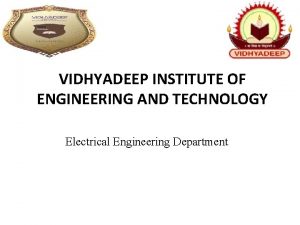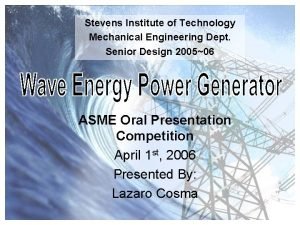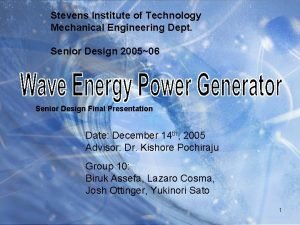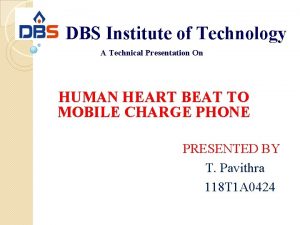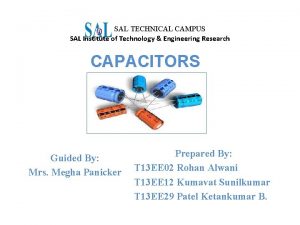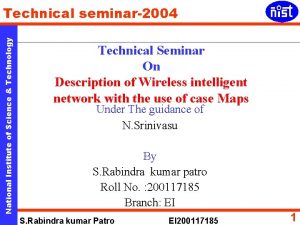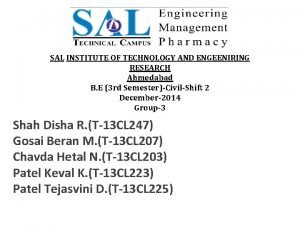SAL TECHNICAL CAMPUS SAL Institute of Technology Engineering
















- Slides: 16

SAL TECHNICAL CAMPUS SAL Institute of Technology & Engineering Research CAPACITORS Guided By: Mrs. Megha Panicker Prepared By: T 13 EE 02 Rohan Alwani T 13 EE 12 Kumavat Sunilkumar T 13 EE 29 Patel Ketankumar B.

CAPACITORS

Introduction • Electrostatics is a branch of science dealing with electricity at rest. • Capacitors come under electrostatics. • Two conducting surfaces separated by a layer of insulating medium is called a capacitor. • Capacitor is also called as “condenser”. • Capacitance is the property of body to store electric charge. Conducting surface 1 Conducting surface 2 Insulating material

Structure of capacitor • The two conducting surfaces of capacitor are known as “capacitor plates”. • The insulating material between the plates is called as the “dielectric”. • Various dielectrics are : - air, mica, glass, waxed paper, ceramic etc. • The shape of conducting surfaces may be circular, spherical or cylindrical.

Working of Capacitor • • When switch ‘S’ is closed, Free electrons from plate A are attracted by “+ve” terminal of battery. Deficiency of electrons on plate A creates a “+” charge on it. The electrons are transferred from + terminal of battery to – terminal of battery. The “-ve” terminal repels these electrons towards plate B, creating an excess of electrons there. Thus a potential difference is established between plates A and B. The movement of electrons will continue till the potential difference between the two plates becomes exactly equal to the emf of battery(i. e V volts). Hence the charge(Q) is accumulated between the plates of capacitor. The charge is found to be directly proportional to the applied voltage(V).

Contd… • • • Q QαV Or, Q/V = C Where, = charge on the capacitor plates in coloumb V = potential difference between the plates in volts. C = Capacitance in farads. Thus, Capacitance is defined as the ratio of the charge on capacitor plates to the potential difference across its plates. + + + _ _ -

Parallel plate capacitor with uniform Dielectric medium • The capacitance ‘C’ of a parallel plate capacitor with a single dielectric medium is given by. . d +Q -Q A C = er eo A/d Where, er= relative permittivity of the medium. eo= Absolute permittivity. V

Parallel plate capacitor with composite dielectric medium • The capacitance ‘C’ of a parallel plate capacitor with three different dielectric medium is given by, E 1 E 2 E 3 εr 1 d 1 v 1 εr 2 d 2 v 2 εr 3 d 3 v 3 V

Capacitor in series • Q is same in all the three capacitors • V is divided in all the three capacitors • V = V 1 + V 2 + V 3 • Hence, total capacitance is given by: - C 1 V 1 C 2 V C 3 V 3

Capacitor in parallel • V is same in all the three capacitors. • Q is divided in all the three capacitors. • Q = Q 1 + Q 2 + Q 3 • Hence, total capacitance is given by: - V Q 1 C 1 Q 2 C 2 Q 3 C 3

Energy stored in capacitor • During charging of capacitor, the voltage source has to spend some energy. • This energy is stored in the electrostatic field of charged capacitor and is given by the equation.

Charging of capacitor • When capacitor is connected across a voltage supply(E), it gradually charges till the voltage across capacitor(Vc) is equal to supply voltage(E) • The rate of capacitor charging is given by: Vc = E(1 – e-t/RC) Where RC = λ(Time constant) • λ is the time taken by the voltage across capacitor to reach 63. 2 % of its final value

Discharging of capacitor • When capacitor is removed from voltage supply(E) and connected across any load, the capacitor gradually discharges till the voltage across capacitor(VR) reaches zero volts. • The rate of capacitor discharging is given by: VR = Ee-t/RC Where RC = λ(Time constant) • λ is the time taken by the voltage across capacitor to decay to 37% of its initial maximum value.


Applications Capacitors are used in many applications like 1. Timing circuits. 2. Electronic flash lamps for camera 3. Line conditioners 4. Electronic power supplies 5. Regulators.

Thank you
 Vidhyadeep institute of engineering and technology
Vidhyadeep institute of engineering and technology Reel to reel institute
Reel to reel institute Mandava institute of engineering and technology
Mandava institute of engineering and technology Fromme423
Fromme423 Guru nanak institutions technical campus
Guru nanak institutions technical campus Michigan career and technical institute
Michigan career and technical institute National technical university kharkiv polytechnic institute
National technical university kharkiv polytechnic institute Calc institute of technology
Calc institute of technology Waterford institute of technology vacancies
Waterford institute of technology vacancies Spike unist
Spike unist Assistive technology implementation plan
Assistive technology implementation plan Masdar institute of science and technology
Masdar institute of science and technology Madhav institute of technology and science
Madhav institute of technology and science Grenoble institute of engineering
Grenoble institute of engineering Gastechnology
Gastechnology Aperture stop
Aperture stop Dbs institute of technology
Dbs institute of technology
